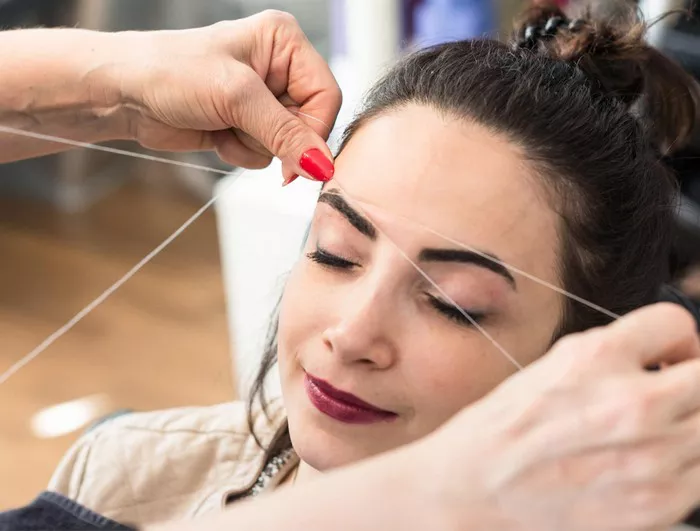Threading of the face, also known as facial threading, is a cosmetic procedure that involves the use of thin, sterile threads to lift and tighten the skin on the face. This non-surgical treatment has become increasingly popular in recent years as a less invasive alternative to traditional facelifts. In this article, we will explore the process of threading of the face, its benefits and risks, and what to expect during and after the procedure.
What is Facial Threading?
Facial threading is a minimally invasive cosmetic treatment that involves the use of fine, biodegradable threads to lift and tighten the skin on the face. The threads are typically made from polydioxanone (PDO), a biocompatible material that has been used in medical applications for many years. The threads are inserted into the skin using a small needle, and then pulled taut to create a lifting effect. The threads are then anchored in place and left in the skin, where they stimulate the production of collagen and elastin, helping to firm and tighten the skin over time.
How Does Facial Threading Work?
Facial threading works by using the threads to lift and tighten the skin on the face. The procedure is typically performed under local anesthesia to minimize discomfort. The threads are inserted into the skin using a small needle, and then pulled taut to create a lifting effect. The threads are then anchored in place and left in the skin, where they stimulate the production of collagen and elastin, helping to firm and tighten the skin over time.
Benefits of Facial Threading
Facial threading offers several benefits over traditional facelifts and other cosmetic treatments. Some of the key benefits of facial threading include:
- Non-Surgical: Facial threading is a non-surgical treatment that can be performed in a doctor’s office or clinic. There is no need for general anesthesia, and the procedure typically takes less than an hour to complete.
- Minimal Downtime: Because facial threading is a non-surgical treatment, there is minimal downtime associated with the procedure. Most patients are able to return to their normal activities within a day or two.
- Natural Results: Facial threading produces natural-looking results that can last for several months to a year. The threads stimulate the production of collagen and elastin, helping to restore a more youthful appearance to the skin.
- Versatility: Facial threading can be used to lift and tighten various areas of the face, including the forehead, cheeks, jowls, and neck.
Risks of Facial Threading
Like any cosmetic procedure, facial threading carries some risks and potential complications. Some of the risks of facial threading include:
- Swelling and Bruising: Some swelling and bruising may occur after the procedure, but this typically resolves within a few days.
- Infection: Although rare, there is a risk of infection associated with any procedure that involves breaking the skin. Patients should take care to keep the treated area clean and avoid touching it for several days after the procedure.
- Allergic Reaction: Some patients may be allergic to the materials used in the threads. It is important to discuss any allergies or medical conditions with your doctor before undergoing the procedure.
- Thread Migration: In some cases, the threads may migrate or become visible under the skin. This can usually be corrected with a minor follow-up procedure.
What to Expect During and After the Procedure
Before the procedure, the doctor will numb the treatment area with a local anesthetic to minimize discomfort. Once the area is numb, the threads will be inserted into the skin using a small needle. The threads will then be pulled taut to create a lifting effect, and anchored in place. The procedure typically takes less than an hour to complete.
After the procedure, patients may experience some swelling and bruising, but this typically resolves within a few days. Patients are advised to avoid touching or rubbing the treated area, and to avoid strenuous activity for several days after the procedure. Patients should also avoid exposure to sunlight and wear sunscreen to protect the treated area.
Results of Facial Threading
The results of facial threading are usually visible immediately after the procedure, and continue to improve over the following weeks and months as the threads stimulate the production of collagen and elastin. The results typically last for several months to a year, depending on the individual patient and the area treated. In some cases, patients may choose to undergo a follow-up procedure to maintain the results.
Cost of Facial Threading
The cost of facial threading varies depending on the extent of the treatment and the area of the face being treated. On average, the cost of facial threading ranges from $1,000 to $2,500. This is significantly less expensive than traditional facelifts, which can cost upwards of $10,000.
Conclusion
Facial threading is a minimally invasive cosmetic treatment that can help to lift and tighten the skin on the face. The procedure is non-surgical, has minimal downtime, and produces natural-looking results that can last for several months to a year. Like any cosmetic procedure, facial threading carries some risks and potential complications, but these can be minimized by choosing a qualified and experienced doctor. If you are considering facial threading, it is important to consult with a qualified cosmetic surgeon to discuss your options and determine whether this procedure is right for you.


